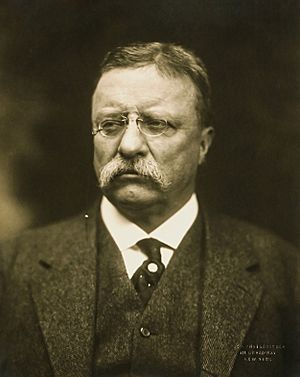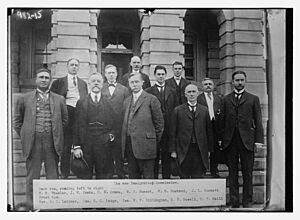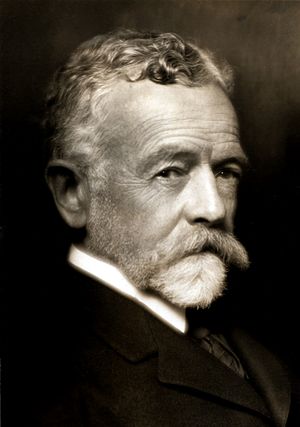United States Congressional Joint Immigration Commission facts for kids
The United States Immigration Commission, also known as the Dillingham Commission, was a special group formed in February 1907. It was named after its leader, William P. Dillingham, a Republican Senator from Vermont. This group was created by the United States Congress and the President, Theodore Roosevelt. Their main job was to study why so many people were moving to the United States and what effects this was having.
The Commission wanted to understand the social, economic, and moral situation of the country because of immigration. For over three years, more than 300 people worked for the Commission. They spent over a million dollars and collected a huge amount of information.
This group included members from both the House and the Senate. In 1911, the Commission shared its findings. They concluded that immigrants from Southern and Eastern Europe were a serious concern for American society. They suggested that immigration from these areas should be greatly reduced. They also wanted to continue limiting immigration from China, Korea, and Japan. This report had a big impact on public opinion. It helped lead to new laws like the 1921 Emergency Quota Act and the 1924 Johnson-Reed Act.
Contents
Why Was the Commission Formed?
The population of America grew a lot between 1800 and 1914. In 1800, there were about 5 million people. By 1914, immigration had added 50 million more people. By 1900, the total population was 77 million.
In the past, immigration rules were mostly about money and jobs. But new ideas started to influence public opinion. Some people began to believe in eugenics, which is a false idea about improving the human race. This led to racial scientific theories. Writers like Madison Grant argued that older immigrant groups were in danger of being replaced by "inferior" races. These "inferior" groups were often seen as people from Southern and Eastern Europe.
Some historians believe that these ideas about eugenics supported the new immigration policies. However, other experts point out that economic reasons were also very important to the Commission members. For example, labor leaders like Samuel Gompers, who was the President of the American Federation of Labour, worried that immigration negatively affected American workers. These concerns also pushed for the creation of the Dillingham Commission.
Historian Robert F. Zeidel says the Commission was part of the Progressive Era. During this time, Nativism (a belief that native-born citizens are better than immigrants) became a strong reason for immigration laws. Before World War I, most immigration limits were only for people from Asia. Other factors like income and education were considered first. Earlier laws had banned criminals, people with mental illness, or serious disabilities. Nativism changed this by creating a system where some races were seen as "superior" to others.

How Did the Commission Investigate?
There was a lot of disagreement between nativists and those who wanted to reform immigration rules. Nativists wanted to limit immigration more. Others wanted to welcome "good" immigrants into American society. This tension influenced the Dillingham Commission's work.
The Commission aimed to use a scientific approach. They planned to visit Europe and other places linked to immigration to the U.S. They wanted to use this information to decide which immigrants would be best for America's needs. This idea of classifying people by race was not new. It was a popular way to support nativist ideas at the time.
Interestingly, the data the Commission collected did not actually support their racial ideas. Immigrants often succeeded and fit into society well. But the Commission still made recommendations based on their beliefs.
The report stated that "old" immigrants from North and Western Europe were from "progressive" areas and fit in quickly. On the other hand, "new" immigrants from Eastern and Southern Europe gathered separately. This made their assimilation (fitting in) slow.
The Commission favored "old" immigrants and opposed "new" immigrants from Eastern and Southern Europe and Asia. The Commission's findings were very influential because they claimed to be based on "scientific research." However, the Commission did not hold public meetings. They also did not question witnesses. They chose not to use information from official sources like census reports or state labor offices. Instead, the Commission used its own investigators. These investigators often made racial differences between immigrant groups. For example, they described Polish immigrants as resembling the "Eastern" or "Slavic" race. They said Russian immigrants were "clannish," meaning they stuck together in groups. This was seen as a reason for them not fitting in.
When looking at education, only 2 out of 26 questions on their assessment forms were about student achievements. They did not consider economic differences when judging literacy levels. The Commission believed that speaking English was very important. They thought it helped with jobs and showed how well immigrants were fitting in.
What Did the Commission Recommend?
The Commission suggested several rules for future immigration laws:
- Immigrants should be chosen based on their quality and how well they might fit into American society.
- New laws must consider businesses and the economy. This was for the benefit of all Americans.
- A country's health is not just about money or trade. It also needs to provide opportunities for its citizens to grow.
- Industry should grow slowly. This allows new workers to mix with Americans already living there. Fast growth could bring in workers with lower living standards. This might negatively affect wages and working conditions for everyone.
The Commission also agreed on these points:
- Immigrants convicted of serious crimes within five years of arriving should be sent back.
- The President should appoint officials to work with other countries. These officials would get police records. People could only enter the U.S. if they had no criminal record.
- Immigrant sailors should follow existing laws.
- An immigrant who needed public assistance within three years of arrival should be sent back.
- All previous recommendations should be regularly enforced by Congress. This was especially true for women brought in for bad reasons.
- A law should be passed to protect immigrants on ships. Government officials should be allowed to go onto the lower decks of ships, even disguised as immigrants. This would be done under the Bureau.
- Special boards should be created to review appeals and other issues.
The Commission also wanted to protect immigrants from being taken advantage of. They suggested that states regulate immigrant banks and employment agencies. They recommended deporting immigrants who encouraged others to send money overseas. This was seen as preventing them from fitting in. Finally, they suggested that states needing more settlers should provide information about farming opportunities. This would attract immigrants willing to help with agriculture.
The Commission also agreed that:
- The need for workers in new industries should be reviewed by the Secretary of Commerce and Labor. This person would decide the conditions for such work.
- The policy that excludes Chinese workers should be extended to East Indians. The British Government should help with this. Japanese and Korean immigration should continue to be questioned.
- Too many unskilled workers are harmful. Therefore, a good number of workers should be kept out of the existing workforce. Also, immigrants who did not plan to become American citizens should be sent back. Those to be excluded were described as "least desirable." This referred to their habits or personal qualities.
The Commission suggested limiting immigrants based on these factors:
- People who could not read or write.
- Setting yearly quotas (limits) for each race by percentage.
- Unskilled workers who came with wives and families.
- Limiting the number of arrivals at ports.
- Increasing the amount of money immigrants needed to have when they arrived.
- Increasing the head tax (a fee paid per person).
- Reducing the head tax for skilled male immigrants with families.
Finally, they decided that literacy tests (reading and writing tests) were the best way to keep "undesired" people out of American society. The Commission suggested more limits on unskilled immigrants. They wanted a literacy test to prove immigrants had enough education to fit into American society. Congress passed bills for this new literacy test. However, Presidents William Howard Taft (in 1913) and Woodrow Wilson (in 1915 and 1917) vetoed them.
What Was the Commission's Impact?
The Dillingham Commission had a big impact on American immigration policy. Its suggestions eventually led to several important changes. These included literacy tests (Congress finally passed one in 1917, overriding President Wilson's veto). It also led to the 1921 Emergency Quota Act and the 1924 Johnson-Reed Act.
These laws put immigration policy firmly in the hands of the national government. Before this, states often handled immigration rules. Immigration from China, Korea, and Japan continued to be limited. The Immigration Act of 1917 even denied entry to immigrants from Eastern Asia and the Pacific islands.
However, the literacy test and head tax from this act were not very effective. They only prevented about 1,500 immigrants from entering each year between 1918 and 1921. Because of these results, a quota system was created to limit immigration based on nationality. The Emergency Quota Act of 1921 allowed only 3% of a specific nationality's population from the 1910 census to enter.
Nativists were still not happy. This led to the Johnson-Reed Act of 1924. This act limited European immigrants to 150,000 per year. It allowed zero Japanese immigrants. For other nationalities, only 2% of their population from the 1890 census was allowed. After this act was enforced in 1929, immigration to America dropped much more.
European immigration to the United States, 1921-1930
- 1921: about 800,000 people
- 1924: about 700,000 people
- 1925-28: about 300,000 people each year
- 1930: less than 150,000 people
Commission Members
|
Senators:
|
Representatives:
|
Unelected:
|
|



